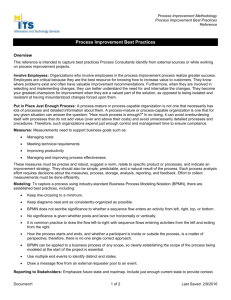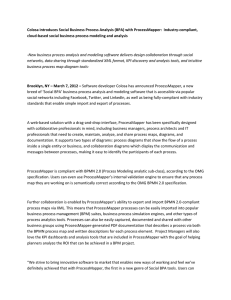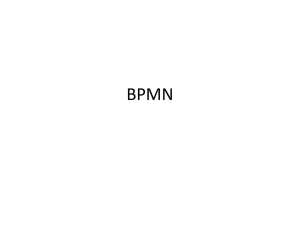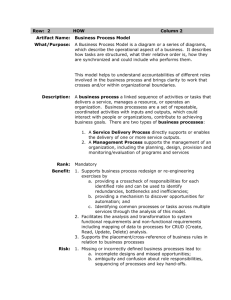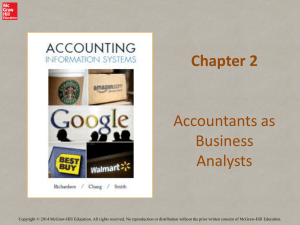www.ijecs.in International Journal Of Engineering And Computer Science ISSN:2319-7242
advertisement
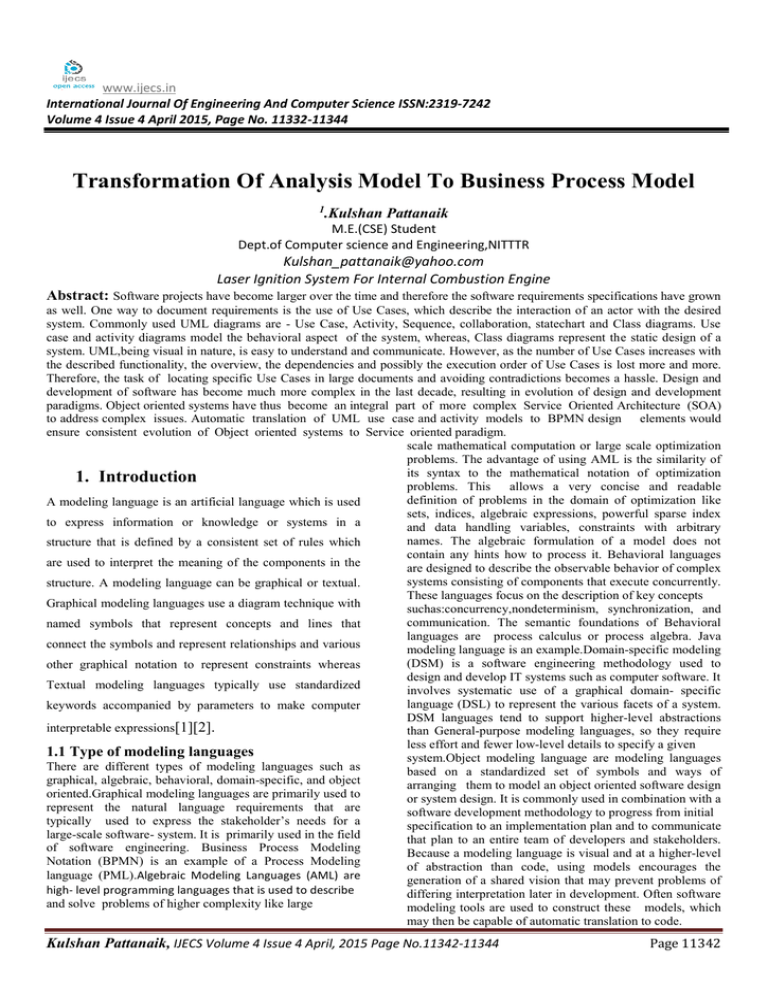
www.ijecs.in
International Journal Of Engineering And Computer Science ISSN:2319-7242
Volume 4 Issue 4 April 2015, Page No. 11332-11344
Transformation Of Analysis Model To Business Process Model
1.Kulshan
Pattanaik
M.E.(CSE) Student
Dept.of Computer science and Engineering,NITTTR
Kulshan_pattanaik@yahoo.com
Laser Ignition System For Internal Combustion Engine
Abstract: Software projects have become larger over the time and therefore the software requirements specifications have grown
as well. One way to document requirements is the use of Use Cases, which describe the interaction of an actor with the desired
system. Commonly used UML diagrams are - Use Case, Activity, Sequence, collaboration, statechart and Class diagrams. Use
case and activity diagrams model the behavioral aspect of the system, whereas, Class diagrams represent the static design of a
system. UML,being visual in nature, is easy to understand and communicate. However, as the number of Use Cases increases with
the described functionality, the overview, the dependencies and possibly the execution order of Use Cases is lost more and more.
Therefore, the task of locating specific Use Cases in large documents and avoiding contradictions becomes a hassle. Design and
development of software has become much more complex in the last decade, resulting in evolution of design and development
paradigms. Object oriented systems have thus become an integral part of more complex Service Oriented Architecture (SOA)
to address complex issues. Automatic translation of UML use case and activity models to BPMN design elements would
ensure consistent evolution of Object oriented systems to Service oriented paradigm.
scale mathematical computation or large scale optimization
problems. The advantage of using AML is the similarity of
its syntax to the mathematical notation of optimization
1. Introduction
problems. This allows a very concise and readable
definition of problems in the domain of optimization like
A modeling language is an artificial language which is used
sets, indices, algebraic expressions, powerful sparse index
to express information or knowledge or systems in a
and data handling variables, constraints with arbitrary
names. The algebraic formulation of a model does not
structure that is defined by a consistent set of rules which
contain any hints how to process it. Behavioral languages
are used to interpret the meaning of the components in the
are designed to describe the observable behavior of complex
systems consisting of components that execute concurrently.
structure. A modeling language can be graphical or textual.
These languages focus on the description of key concepts
Graphical modeling languages use a diagram technique with
suchas:concurrency,nondeterminism, synchronization, and
communication. The semantic foundations of Behavioral
named symbols that represent concepts and lines that
languages are process calculus or process algebra. Java
connect the symbols and represent relationships and various
modeling language is an example.Domain-specific modeling
(DSM) is a software engineering methodology used to
other graphical notation to represent constraints whereas
design and develop IT systems such as computer software. It
Textual modeling languages typically use standardized
involves systematic use of a graphical domain- specific
language (DSL) to represent the various facets of a system.
keywords accompanied by parameters to make computer
DSM languages tend to support higher-level abstractions
interpretable expressions[1][2].
than General-purpose modeling languages, so they require
less effort and fewer low-level details to specify a given
1.1 Type of modeling languages
system.Object modeling language are modeling languages
There are different types of modeling languages such as
based on a standardized set of symbols and ways of
graphical, algebraic, behavioral, domain-specific, and object
arranging them to model an object oriented software design
oriented.Graphical modeling languages are primarily used to
or system design. It is commonly used in combination with a
represent the natural language requirements that are
software development methodology to progress from initial
typically used to express the stakeholder’s needs for a
specification to an implementation plan and to communicate
large-scale software- system. It is primarily used in the field
that plan to an entire team of developers and stakeholders.
of software engineering. Business Process Modeling
Because a modeling language is visual and at a higher-level
Notation (BPMN) is an example of a Process Modeling
of abstraction than code, using models encourages the
language (PML).Algebraic Modeling Languages (AML) are
generation of a shared vision that may prevent problems of
high- level programming languages that is used to describe
differing interpretation later in development. Often software
and solve problems of higher complexity like large
modeling tools are used to construct these models, which
may then be capable of automatic translation to code.
Kulshan Pattanaik, IJECS Volume 4 Issue 4 April, 2015 Page No.11342-11344
Page 11342
2. UML Overview
UML is a standard language used to specify, visualize,
construct, and document the artifacts of software systems
[2][5][6][7][8].UML was created by Object Management
Group (OMG) and UML 1.0 specification draft was
proposed to the OMG in January 1997. UML is different
from the other common programming languages like C++,
Java, COBOL since it deals with the use of pictorial
languages which makes it simple to understand and
implement it to make software blue
prints.
2. Process Modeling
Process Modeling is the art of capturing of an ordered
sequence of business activities and supporting information.
There are different levels of process modeling like Process
Maps that deals with simple flow charts of the activities,
Process Descriptions which includes flow charts extended
with additional information, but not enough to fully define
actual performance and Process Models dealing with flow
charts extended with enough information so that the process
can be analyzed, simulated, and/or executed. Business
Process Modeling Notation (BPMN) is an example of
process modeling[9][10].Two new concepts were introduced
in BPMNwhich created a big difference between UML and
BPMN and they are Orchestration which defines processes
internal to a specific participant, organization. It is a private
process within pool (and between lanes).Sequence Flows
and Message Flows are a part of these and Choreography
that defines interactions between two or more participants,
organizations, B2B, global processes. It deals with public
exchange of messages between pools in a collaboration.
4. Transformation Rules:We used a set of rules to transform Formalize Analysis
model into BPMN Notation.The rules are the defined as
follow:
Rule1
The use case activity whose node is marked as start’ will be
assigned as Start Event of the BPMN node. The BPMN
node will labeled as Activity ID (act_ID) of the activity
node.
Rule 2
The use case activity whose node is marked as ‘end’ will be
assigned as End Event of the BPMN node. The BPMN node
will labeled as Activity ID (act_ID) of the activity node.
Rule3
The use case activity whose node is marked as ‘action /
decision’ will be assigned as Intermediate Event of the
BPMN node. The BPMN node will labeled as Activity ID
(act_ID) of the activity node.
Rule 4
The use case activity whose node is marked as ‘fork’ will be
assigned as Parallel Gateway of the BPMN node if both the
post Element of the activity node are of the type ‘basic’. The
BPMN node will labeled as Activity ID (act_ID) of the
activity node.
Rule 5
The use case activity whose node is marked as ‘fork’ will be
assigned as Exclusive-OR Gateway of the BPMN node if
one the postElement of the activity node are of the type
‘basic’ and the other is of the type ‘alternate’. The BPMN
node will labeled as Activity ID(act_ID) of the activity
node.
5.Algorithm for automated
transformation:
These rules cited in the above section are realized using two
algorithms namely NodeGeneration and FlowGeneration.
The flow of the algorithm is as follow: The elements of
Formalized Analysis Model (FAM) in the form of different
table schema are used as input to the first algorithm named
NodeGeneration. The outputs of this algorithm are different
BPMN nodes. This output along with the Array FAM_Flow
is fed as input to the second algorithm named
FlowGeneration. The Array FAM_Flow is formal method
of storing the flow information of events of FAM. The
Flow Generation algorithm will generate the BPMN design
elements
6. Algorithm for Conversion of
scenarios to BPMN:The algorithm Node Generation as proposed below will
generate the BPMN nodes. We define the algorithm using
the tuple relational calculus. The algorithm is proposed as
follow.# The following query is the realization of rule 1 of
.It generates the Start of the #BPMN node. It selects the
Graphical_notation from BPMN_node and map that #with
the start event of the activity_node {t. Graphical_notation |
BPMN_node (t)
^ t. ID = ‘1’ ^
ActivityState (d) ^ d.activity_node = t.activity_node ^ t.label
= d.act_ID ^ d.activity_node = ‘start’) # The following
query is the realization of rule 2.It generates the End #of the
BPMN node. It selects them Graphical_notation from
BPMN_node and map #that with the end event of the
activity_node {t. Graphical_notation | BPMN_node(t) ^ t.ID
= ‘2’ ^
t.activity_node ^ t.label = d.act_ID ^ d.activity_node =
‘end’)}
7. Conclusion
BPMN supports detection of wrong conditions, missing use
cases, unknown parallelism. Within this project we have
presented an approach to visualizing dependencies and
ordering for use case sets. By using this approach, it is
possible to create BPMN models that make the dependencies
between use cases explicit by using preconditions, post
conditions and triggers. Stake holders and requirements
engineers are therefore able to discuss the ordering and the
conditions of the use cases, which can greatly improve the
quality of the overall use case model. In this project ,we have
proposed an approach for automated translation of
Formalized A nalysis Models, that consists of a formal
grammar based description of UML models used in Analysis
phase, to Business Processes Design and development of
software has become much more complex in the last decade
Kulshan Pattanaik, IJECS Volume 4 Issue 4 April, 2015 Page No.11342-11344
Page 11343
resulting in evolution of design and development paradigms.
Object oriented Systems have thus become an integral part of
more
complex
Service
Oriented
Architecture(SOA).Evolution of software design and
development from object oriented to SOA domain has
become the necessity in this evolving scenario. Thi approach
would help us in seamless evolution of object oriented
systems to service oriented domain. As this model is based
on a formal grammar, this model can be automated resulting
in correct and consistent transformations. The goal of this
project is to propose a frame work for automatic
transformation of UMLanalysis models to BPMN design
elements.
4. ObjectManagementGroup“UnifiedModelingLan
5.
6.
7.
8.
References
1. A. Cockburn “Writing Effective Use Cases,”
2.
3.
11.
Addison-Wesley, 2005.
R. Dijkman, M. Dumas and C. Ouyang
“Semantics and Analysis of Business Process
Models in BPMN,” Information and SoftwarE
Technology (IST), 2008.
D.L¨ubke“Transformation of Use Cases to EPC
Models,”In Proceedings of the EPK 2006
Workshop.
Jayeeta Chanda, Ananya Kanjilal, Sabnam
Sengupta, Swapan Bhattacharya“Traceability of
Requirements and Consistency Verification of
UML Use case, Activity and Class Diagram A
Formal Approach,” Proceedings of International
Conference on Methods and Models in Computer
Science (IEEE ICM2CS), 2009.
12. Jayeeta Chanda, Ananya Kanjilal, Sabnam
9.
10.
18. Wahl, T. Sindre, G “An Analytical Evaluation of
19.
20.
Sengupta, Swapan Bhattacharya “FAM2BP:
Transformation Framework of UML Behavioral
Elements into BPMN Design Element,”.
13. Xiao He, “A Metamodel for the Notation of
Graphical Modeling Languages,” 31stAnnual
International Conference on Computer Software
and Applications 2007.
21.
22.
14. Bock and D. Ryan, “Accuracy in Modeling with
Extended Entity Relationship and Object Oriented Data Models”.
23.
15. S.R. Chidamber and C.F. Kemerer, “A Metrics
Suite for Object Oriented Design,” IEEE
Transactions on Software Engineering, 1994.
24.
16. Long, Q., Liu, Z., Li, X. and Jifeng, H,
“Consistent Code Generation from UML
Models,” In Proceedings of Australian Software
Engineering
Conference, IEEE Computer
Society, 2005.
25.
26.
17. Ouyang, C. Dumas, M. ter Hofstede and A.H.M.
van der Aalst, “W.M.P.
Pattern-based
Translation of BPMN Process Models to BPEL
Web Services,” International Journal
guage Superstructure,”2004
Object Management Group. Business Process
Modeling Notation (BPMN) 1.1,” 2008.
B. Oestereich, C. Weiss, C. Schr¨oder, T.
Weilkiens, and A. Lenhard “UML,”2003.
S. Som´e. “An approach for the synthesis of
State transition graphs from Use Cases,”. In
Proceedings of the InternationaL Conference on
Software Engineering Research and Practice,
2003
S. Som´e. “Supporting Use Cases Based
Requirements Simulation,”In Proceedings of the
International
Conference
on
Software
Engineering and Practice (SERP’04) 2004
J. Whittle, “A Formal Semantics of Use Case
Charts,” Technical Report ISE TR-06-02
.Daniel L¨ubke , Kurt Schneider and Matthias
Weidlich, “Visualizing Use Case Sets as BPMN
Processes”,
Requirements
Engineering
Visualization 2008
27.
BPMN Using a SemiotICnQuality Framework,”
In: Siau, K. (ed.) Advanced Topics in Database
Research, Idea Group, Hershey, Pennsylvania
2006.
S. White, “Using BPMN to Model a BPEL
Process, ” Technical report, BP Trends 2005.
J. Ye, S. Sun, L.Wen, and S.Wen,
“Transformation of BPMN to YAWL,” In
H.Zhou, editor, International Conference on
Computer Science and Software Engineering,
2008.
J. Camara, C. Canal, J. Cubo, and A. Vallecillo,
“Formalizing WSBPEL Business Process using
ProcessAlgebra,’’ InCONCUR’2005
M. Dumas, A. Grosskopf, T. Hettel, and M.
Wynn, “Semantics of Standard Process Models
with OR-Joins,’’ Technical report, Queensland
University of Technology, BPM Center
Technical report 2007.
O. M. Group, “Business Process Modeling
Notation (BPMN) Version 1.0. OMG Fina
Adopted Specification,” Object Management
Group, 2006.
Carbone, M. and Santucci, and G, “Fast &
Serious: a UML Based Metric for
Effort
Estimation,” In 6th ECOOP
Workshop on Quantitative Approaches in
Object-Oriented Software Engineering 2011.
Bock, D., Ryan and T, “Accuracy in modeling
with extended entity relationship and object
oriented data models,”Journal of Database
Management 1993.
Shoval, P. and Shira, “Entity-relationship and
object-oriented data modeling:an experimental
comparison of design quality,” Data Knowledge
of Web Services Research 5, 2008
Kulshan Pattanaik, IJECS Volume 4 Issue 4 April, 2015 Page No.11342-11344
Page 11344
Engineering of the 10th WSEAS international
conference on evolutionary computing, 1997.
Kulshan Pattanaik, IJECS Volume 4 Issue 4 April, 2015 Page No.11342-11344
Page 11345
